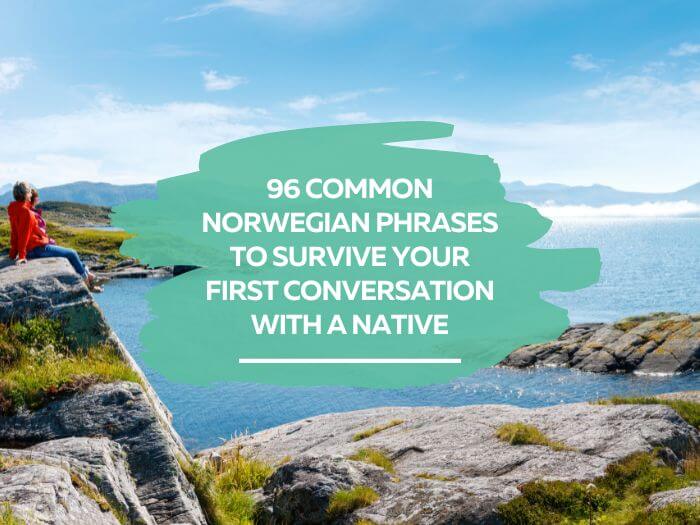As you learn Norwegian, you will find that Norwegians are a straightforward people and their language mirrors their pragmatic, matter-of-fact approach to everyday life.
Most Norwegians, even in the remotest backwaters, speak perfectly acceptable English due to foreign language programming not being dubbed.
Still, you'll make friends faster if you show your willingness to participate (å delta) in Norwegian society by learning some common Norwegian phrases – and behavioural basics – while you navigate around the country.
Let's discover 96 common Norwegian phrases together!
Pro Tip
By the way, if you want to learn Norwegian fast (including common Norwegian phrases) and have fun, my top recommendation is Norwegian Uncovered which teaches you through StoryLearning®.
With Norwegian Uncovered you’ll use my unique StoryLearning® method to learn Norwegian through story…not rules. It’s as fun as it is effective. If you’re ready to get started, click here for a 7-day FREE trial.
Table of Contents
Norwegian Pronunciation Issues

I’ve already introduced some basic Norwegian pronunciation rules in this post: is Norwegian hard to learn? However, as a Norwegian language beginner, you shouldn’t worry too much about how you pronounce things.
Most Norwegians you meet will be delighted that you're bothering to learn this minority language in the first place.
In most circumstances, you will get away by speaking the words how you read them – and let’s face it, as a beginner you'll hardly convince anyone that you are a native speaker!
But as a rule of thumb, Norwegian questions – and you will have a lot of them once you are in Norway – mostly begin with Who (Hvem), What (Hva), Where (Hvor), How (Hvordan) and Why (Hvorfor).
The ‘h’ at the beginning of each word is always silent, while the ‘o’ is pronounced like the English ‘ou’ in “should” or “could”.
You can also start a question or request with “Could you…?” Kan du … or “May I…?” Får jeg … But first you’ll have to learn how to initiate a conversation.
The Norwegian Meeting Ritual
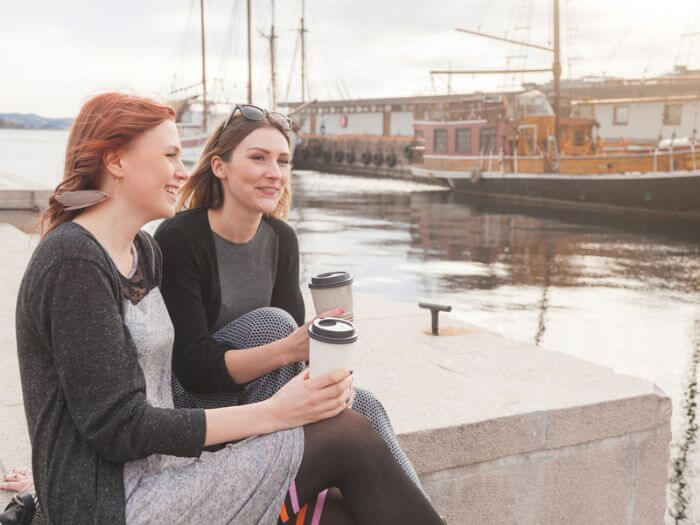
When Norwegians meet each other, the encounter, to begin with, follows the same old ritual with some minor variations.
One person will say “hello” waiting for the reply of the other person before enquiring about their wellbeing.
The words to learn for greeting each other are:
- #1 Hei (Hello, pronounced almost exactly like Hi)
- #2 Hvordan står det til? (How are things? Sometimes abbreviated to Står til?)
- #3 Bra (Good. Pronounced just like the well-known women's garment).
- #4 Og du da (And you?)
Once you’ve gone through these basics, the conversation will go straight to the point of the meeting. Or stay on the also not unimportant topic of været (the weather).
When all that can be said has been shared and you've decided to part ways, all parties involved in the encounter will generally say:
- #5 Ha det! (Bye! A direct translation would be “Have it!”) or
- #6 Ha det bra! (Goodbye!)
While hei and ha det initially are informal greetings, the expressions are also used universally when you for example enter or leave a shop or office, approach someone for information – or simply buy a ticket at a counter or on public transport.
Travelling Around Norway
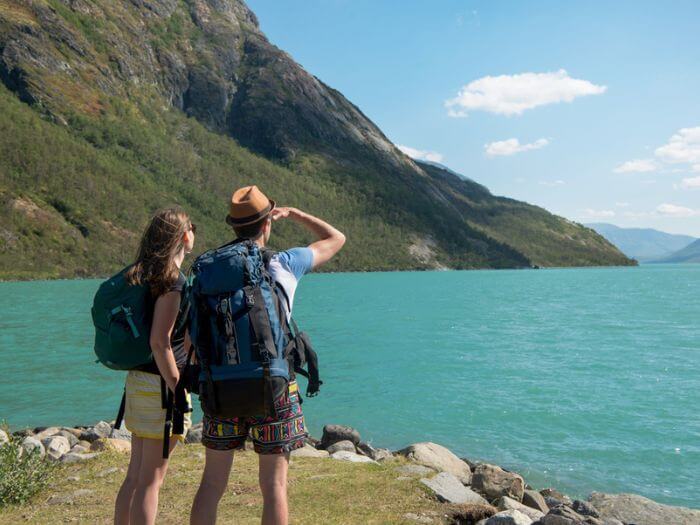
When you first arrive in Norway, you'll probably want to see more than just the major towns as the country is more famous for its mountains and fjords (fjell og fjorder) than its inner-city landmarks.
Whether you buy your tickets at a train/metro station, with a bus driver or in one of the many kiosks, you will have to state where you're going to.
- #7 Jeg skal gå til… (I want to go to…)
- #8 Hva koster det? (How much does it cost?)
- #9 Hvor langt er det til? (How far is it?)
- #10 Hvor lang tid tar det? (How long does it take?)
- #11 Hvor mange holdeplasser? (How many stops?)
Once you've received the required information, Norwegians will appreciate some form of recognition for their efforts and you might want to learn how to show your appreciation.
Showing Gratitude, The Norwegian Way
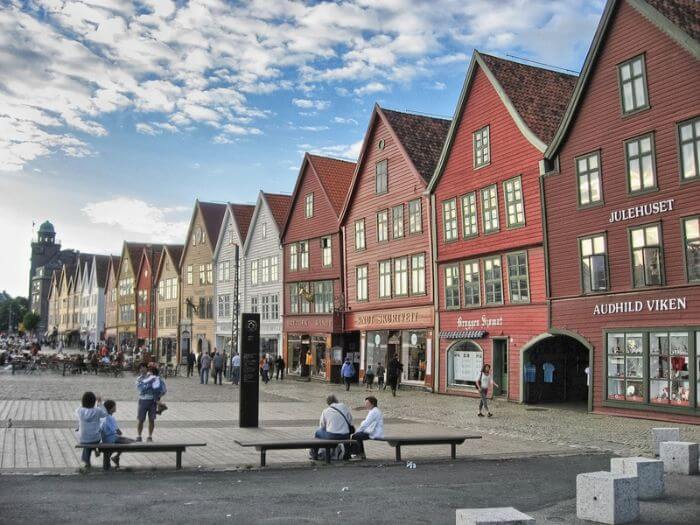
Whether you're given information, presents or any other form of (pleasant) attention, you're also expected to be grateful in Norway.
The most common reactions to assistance given would depend on your level of gratitude:
- #12 Takk! (Thanks!).
- #13 Takk skal du ha (Thank you).
- #14 Mange takk! (Many thanks!).
- #15 Tusen takk! (Thanks a million!).
If you want to be formal, you can also reply in writing, starting with Jeg takker so meget for … (I thank you very much for…), but this is only necessary after a very grand – as in expensive – occasion.
It is, however, absolutely essential that you acquaint yourself with the charming Norwegian rite of saying thanks for your meal, especially if you're invited out or eating in a private residence.
It's one of the first ‘manners’ small children are taught at the breakfast table – to thank their mother or father for the effort of putting food on the table. The expression is invariably always the same:
- #16 Takk for maten (Thank you for the meal).
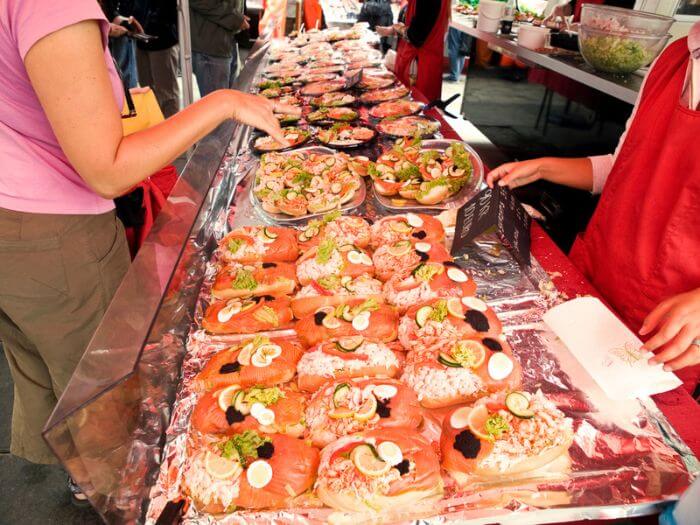
Norwegians regard it as downright rude – if not a capital offense – lest you forget this simple phrase and you might not be invited back as a result.
Luckily, everybody at the table will say it to the host/hostess which should give you the prompt when it’s your turn.
Not liking the food, by the way, does not excuse you from saying thank you for it. A friend of mine once was invited to a communal Lutefisk-dinner in Northern Norway. Just glancing at the wobbly fish-mess (she had paid for) made her stomach churn.
However, her table companions were positively horrified at her suggestion of being excused from saying thanks for the food. The rule is: take it or leave it – but never ever forget to be thankful for it.
Asking For Help In Norway
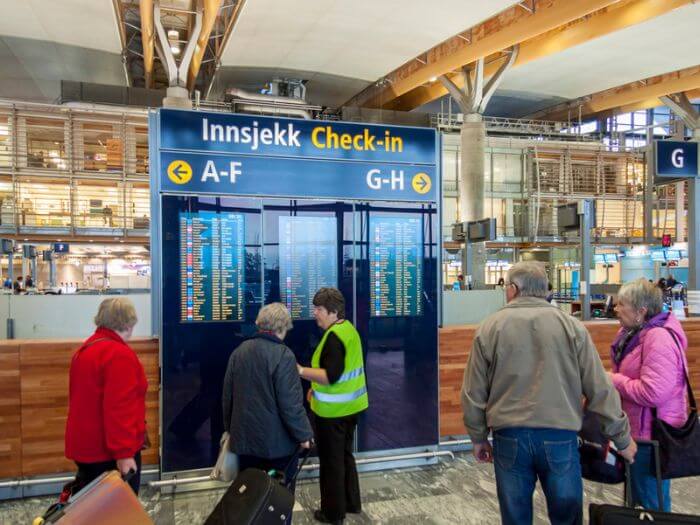
The English nicety “please” has at least two corresponding common Norwegian phrases, which can be used interchangeably. The most common is:
- #17 Vær så snill! (Please! This is a direct translation of “be so kind”).
Vær så snill! can stand alone, without being integrated into a full sentence. If you’d like to ask for something in a full sentence, you can say:
- #18 Kan du vennligst fortelle meg … (Could you please tell me…?)
- #19 Kan du være så snill å vise meg … (Could you please show me…?)
In both circumstances, you can swap vennligst with være så snill and the other way around. You even can mix them up into:
- #20 Kan du være så vennlig å minne meg på … (Would you be so kind to remind me of…)
Beware vennlig though!
When used wrongly, or placed in first position within a sentence, vennlig in its superlative degree vennligst soon can turn a harmless request for help into an imperious demand or even categorical order, especially in combination with the word ikke (don’t).
How Friendly Is The Norwegian Word For “Friendly”?
The Norwegian term for friend is en venn (a male friend) or ei venninne (a female friend). The root of the word is the basis for vennlig (friendly) which you might encounter as soon as you receive your first written communication in Norwegian.
- #21 Med vennlig hilsen (With kind regards)
This is the most common way to conclude a letter or email – in business as well as informally. Yet you might be surprised to find the same word on many warnings or even prohibition signs around Norway:
- #22 Vennligst ikke rør (Please don’t touch).
- #23 Vennligst ikke forstyrr (Please don’t disturb).
- #24 Vennligst la dyrene være i fred (Please leave the animals alone).
But anyone who addresses you, starting with
- #25 Vennligst la det være (Please leave it).
- #26 Vennligst send inn skjemaet innen … (Please send in this form by…)
- #27 Vennligst vær her i god tid (Please be here on time).
is not necessarily your friend (vennen min) – but most likely someone who is demanding something.
In most circumstances, you might notice a certain impatience or even truculence in the Norwegian speaker’s voice when starting with vennligst – and you’ll know it’s time to dive for cover.
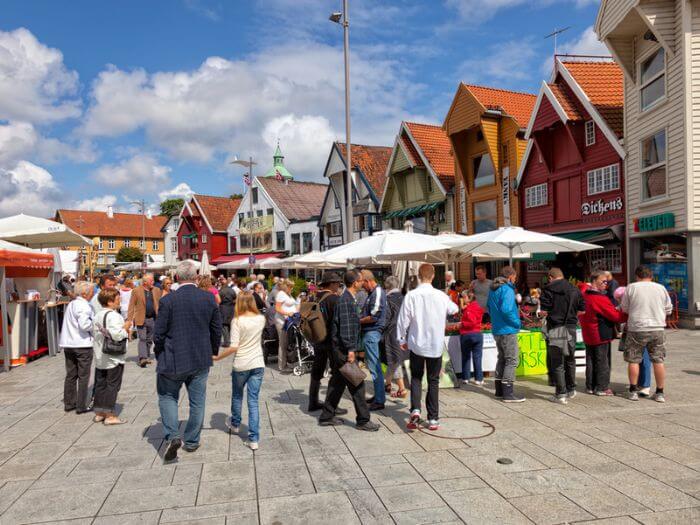
On the whole, however, vennlig is used to describe pleasant environments or people.
- #28 Jeg har vennlige kolleger (I have friendly colleagues).
When you talk about animals, meet an especially helpful person or try to teach children to be nice to each other, you most likely will use the Norwegian word for kind (snill).
- #29 Han er en snill hund og biter ikke. (He’s a friendly dog and doesn’t bite).
- #30 Hun var så snill å hjelpe meg (She was so kind to help me)
- #31 Vær snille mot hverandre! (Be nice to each other!).
The most important word on the Norwegian ‘friendly spectrum’, however, will be a variation of the imported Danish term Hygge.
You will hardly ever have a Norwegian conversation, without the word hyggelig (nice, good, comfortable, friendly) appearing at least once.
- #32 Han er veldig hyggelig (He is very nice).
- #33 Hun bor I et hyggelig nabolag (She lives in a good neighbourhood).
- #34 Vi har hatt en hyggelig kveld (We have had a nice evening).
- #35 Nå har de det hyggelig (They are having a good time).
- #36 Hyggelig å møte deg (Nice to meet you).
Like in Denmark, in Norway hygge also involves good company, a pleasant atmosphere – and very often also good food.
Common Norwegian Phrases For Eating Out in Norway
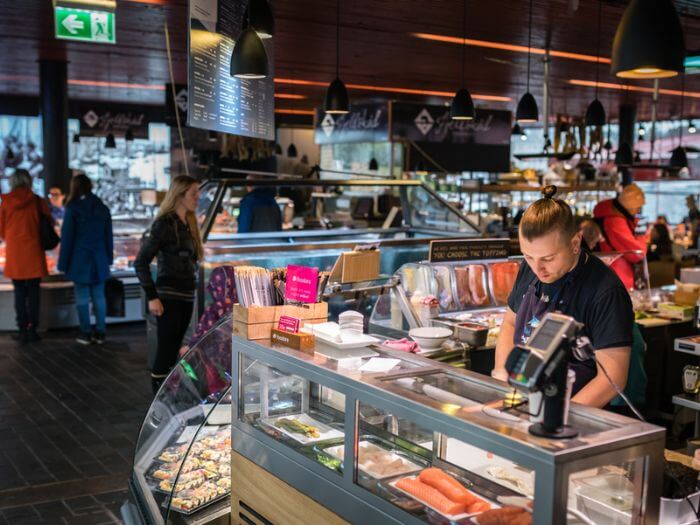
As a traditional seafarer nation, Norway obviously has outstanding fish and seafood cuisine on offer. To the consternation of many visitors from outside the Nordic countries, whale meat (hvalkjøtt) might be part of the menu.
There is, however, no point in arguing the case against whaling as the result will be at best that you are ignored.
At worst you will find yourself in the centre of a tedious political debate lasting all night. Either way, the evening would be ruined – while the whale stays on the menu where it’s been ever since hospitality began in Norway.
My best advice would be to adopt the Norwegian take-it-or-leave-it approach and go somewhere else if the whale meat offends you. Alternatively, you could enquire already when booking the table if they serve whale meat.
- #37 Unnskyld, men serverer dere hvalkjøtt? (Excuse me, but do you serve whale meat?)
- #38 Det gjør vi dessverre/heldigvis (Unfortunately/fortunately we do).
By the way, the Norwegian expression Unnskyld stands for “I am sorry” as well as “Excuse me”. A Norwegian waiter also might say beklager instead of Unnskyld as a form for “I apologise” or “I regret to inform you”.
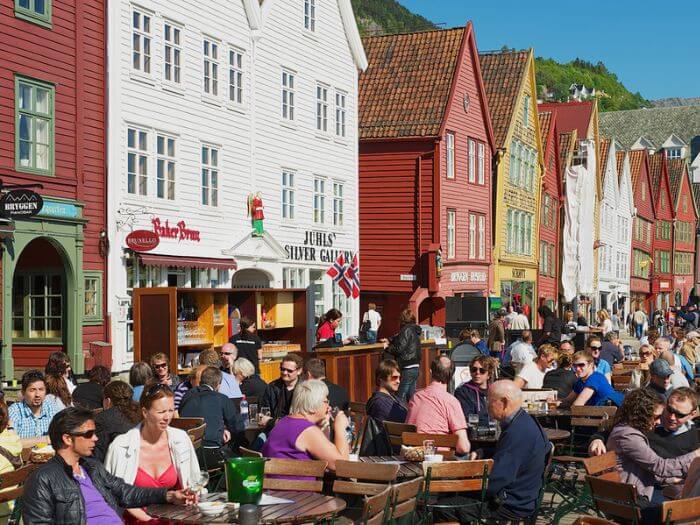
Other, more common Norwegian phrases for eating out in Norway would be:
- #39 Et bord for to/tre/fire, takk. (A table for two/three/four, please).
- #40 Kan jeg få menyen? (May I have the menu?).
- #41 Kan vi få litt vann, takk? (Could we have some water, please?).
- #42 Hva kan du anbefale? (What would you recommend?).
- #43 Jeg vil gjerne ha en forrett, men ingen dessert (I would like a starter, but no dessert).
- #44 Hva slags øl har dere? (What kind of beer do you have?).
- #45 Kan vi få se vinkartet, takk? (Could we please see the wine list?)
- #46 Maten var utmerket, takk. (The food was excellent, thank you).
- #47 Kan vi få regningen, takk? (Could we have the bill, please?).
You might have noticed that the polite vær så snill (please) has turned into a preemptive takk (thank you) when asking for something in a restaurant.
This is a common practice in the service sector where you're expected to pay at the end. You could replace takk by inserting vær så snill or vennligst into the sentence, like
- #48 Kan jeg vær så snill/vennligst få frakken min? (May I have my coat, please?)
without breaking any language rules, but it would appear odd and brand you immediately as a foreigner.
Love And Social Life In Norway
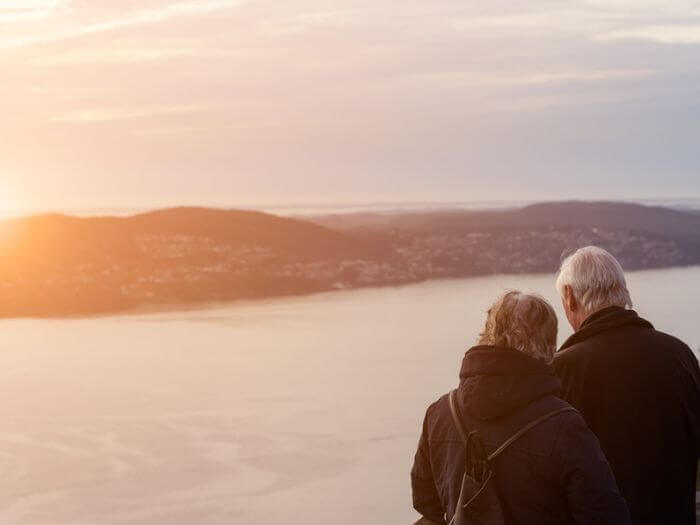
I've already mentioned venn (friend) and venninne (girlfriend), which are both expressions reserved to describe platonic relationships.
To distinguish a friend from that special boyfriend or girlfriend, the Norwegians use the unisex term min kjæreste.
There are also clear distinctions between common law partners, married couples and extramarital lovers.
- #49 Jeg har fått meg en kjæreste. (I have a girl/boyfriend now).
- #50 Jeg er ikke gift, men jeg har en samboer. (I’m not married, but I have a partner).
- #51 Får jeg presentere min kone/ektemann? (May I introduce my wife/husband?).
- #52 Hun er ikke hans kone, men hans elskerinne. (She's not his wife, but his lover).
In addition, you'll come across the expression en ektefelle (a spouse) in mainly official forms to be filled in, like:
- #53 Ektefellens inntekt (Spousal income)
If you've not come so far as to put the vocabulary above to good use, here are a few common Norwegian phrases that should help you on your way.
- #54 Jeg liker deg (I like you).
- #55 Jeg bryr meg om deg (I care about you).
- #56 Jeg elsker deg (I love you).
- #57 Har du lyst til å gå ut med meg noen gang? (Would you like to go out with me sometimes?)
- #58 Hva med i kveld? (How about tonight?)
- #59 Hvor spennende (How interesting).
- #60 Hvor veldig spennende (How very interesting – Be careful not to overdo it. Norwegians are chiefly down-to-earth and rarely susceptible to exaggerated flattery).
- #61 Du har vakre øyne/lepper/ører/føtter osv. (You have nice eyes/lips/ears/feet etc. Same rule on flattery applies as above. For further inspiration on body parts, look here).
- #62 Ditt sted eller mitt? (Your place or mine?).
Other terms of endearment you might find handy are:
- skatten min (my darling, translates literally as “my treasure”)
- min elskede (my love)
- kjære (dear – like in English, it can also be used in an ironical sense and to introduce a letter or email)
- and elskling (sweetheart or also another way to say darling).
The Norwegian word for love is kjærlighet.
Common Norwegian Phrases For Going Shopping In Norway
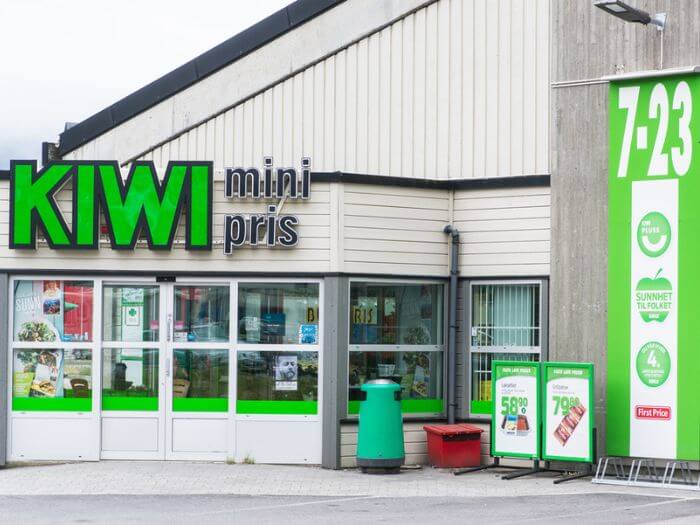
Eating out in restaurants can become expensive in the long run and I've never met anyone capable of living on love alone. This means that you'll have to go into a Norwegian supermarket or food shop at some point.
While Norwegian supermarkets at first glance look like any other European shopping centre, Norwegians wouldn’t be Norwegians if they didn't have a few surprises ‘in store’.
To begin with, you’ll look for the spirit and wine aisles in vain. Prohibition is to a certain extent still a reality in Norway and you’ll have to go to special government operated shops called Vinmonopolet (the Wine Monopoly) to get your booze.
Also beer with an alcohol by volume (ABV) content above 4.7% – meaning anything worthwhile considering as such – will only be sold in Vinmonopolet.
The other surprise arises when you take a closer look at the shelves – and at what Norwegians will put in their trolleys. You'll soon discover that you have not seen anything like it outside the Norwegian borders.
Here are a few common Norwegian phrases mentioning some of the most popular food products in the country.
- #63 En boks med torskerogn (One tin of cod roe – once entirely freed from the tin, the solid block is cut into slices, fried and eaten as part of a sandwich).
- #64 To pakker brunost (Two packets of ‘brown cheese’ – quite strictly speaking not a cheese but a whey product from goat’s or cow’s milk or a mixture of both. You will hardly find a Norwegian fridge without it).
- #65 Tre tuber kaviar (Three tubes of caviar – not what you might think, but a popular creamed cod roe spread. Else I wouldn’t have asked you to buy three…)
- #66 Fire poser med lomper (Four bags of Lomper – pronounced loomper, a typical Norwegian wrap made of potatoes and flour eaten with hot dogs, universally known as pølse med lompe).
- #67 Fem glass med tyttebærsyltetøy (Five jars of lingonberry jam – tastes a bit, but not quite like cranberry sauce).
- #68 Seks stykker salt sild (Six pieces of Salt Sild – the literal translation is ‘salty herring’, a Norwegian liquorice with a tendency to stick to your teeth. More than six pieces and you will need a dentist, see below).
- #69 Syv skjefuller av fiskeboller (Seven spoonful of fish balls – Norwegian dinner stable no supermarket ever would dare not to offer).
- #70 Åtte skiver reinsdyrpølse (Eight slices of reindeer sausage).
- #71 Ni striper av spekeskinke (Nine strips of cured ham).
- #72 Ti bjørkepinner til pinnekjøtt (Ten birch sticks for Pinnekjøtt – a traditional Christmas dish consisting of mutton or lamb steamed over birchwood).
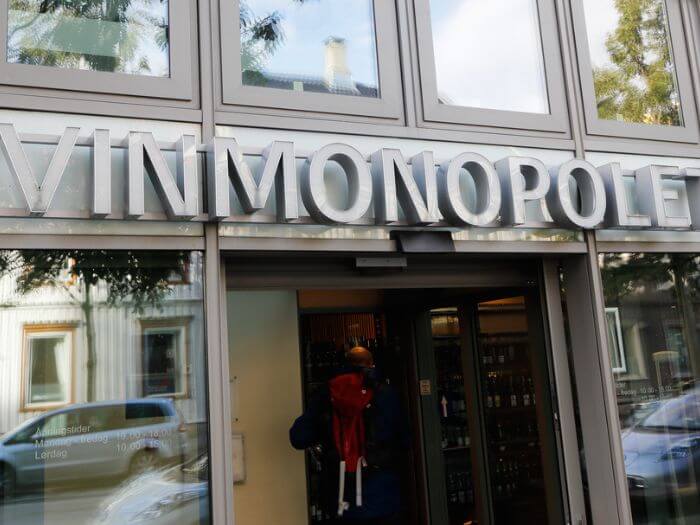
On your way home, you probably want to drop in at Vinmonopolet to stock up on the house bar.
Vinmonopolet always has counter service, usually with a numbered queue system and you'll have to address the shop assistants (ekspeditør for male/ ekspeditrise for female) with Kan jeg få (may I have):
- #73 En flaske Akevitt (A bottle of Aquavit)
- #74 En sekspakning med norsk øl (A six-pack of Norwegian beer)
- #75 Et fat med vin (a barrel of wine – not very likely you get it though as there are also restriction on the amounts you are allowed to buy).
Despite Norway’s restrictive alcohol policies raising eyebrows everywhere else in the world, Norwegians themselves are not overly bothered by adhering to the high prices and shortened opening hours of Vinmonopolet.
Norway, however, has a flourishing – and highly illegal – home manufacturing trade of liquors, known as hjemmebrent (distilled at home, known elsewhere as Moonshine).
Now and again, you might read in newspapers of entire neighbourhoods being poisoned. There is also always the danger of explosions, which takes us to the next topic.
Dealing With An Emergency In Norway

The essentials first: the phone numbers for the Norwegian emergency and rescue services are as follows:
- Police (Politiet) – 112
- Ambulance (Ambulanse) – 113
- Fire (Brannvesenet) – 110
In addition, you also should learn by heart
- Sea Rescue (Sjøredning) – 120
- Mountain Rescue (Fjellredning) – 112 & 113
If you are very stressed, calling 112 will suffice and the right department will be informed. In all circumstances, you'll be required to give the following information:
- #76 Jeg heter … (My name is…)
- #77 Jeg er ved … (I am at/in… – please give exact address and/or GPS location you can find on your phone).
- #78 Det har skjedd en ulykke (There has been an accident).
- #79 Vi har gått oss vill på havet/i fjellene (we have lost our way on the sea/in the mountains).
- #80 En/to/tre osv. personer ble skadet (One/two/three etc people got hurt).
- #81 Vennligst send en ambulanse/helikopter/kystvaktbåt (Please send an ambulance/helicopter/coast guard boat).
For non-emergency healthcare, including dental treatments, you can contact Helsenorge (Norwegian Health Service). While the Norwegian health service generally is free, dental care will have to be paid for.
Here are a few common Norwegian phrases you might want to use when you need health care in Norway.
- #82 Jeg trenger en fastlege (I need a GP).
- #83 Jeg er på utkikk etter en tannlege (I am looking for a dentist).
- #84 Jeg har vondt i hodet/maven/nakken osv. (My head/tummy/neck etc. hurts).
- #85 Jeg har tannverk (I have a toothache).
- #86 Må jeg dra til sykehuset? (Do I have to go to the hospital?).
- #87 Kan jeg få snakke med sykepleieren? (May I speak to the nurse?).
- #88 Har legen tid nå? (Is the doctor available now?)
If you, despite my warnings, should become involved in the hjemmebrent (Moonshine) circulation, you might want to add Jeg er blitt blind (I have gone blind) and Huset mitt har eksplodert (My house has exploded) to your Norwegian health and emergency vocabulary.
Concluding Something The Norwegian Way

All things – good or bad – eventually come to an end and it pays well to know the signs also in Norwegian. The most essential term to know is slutten (the end), though there are a few variations.
- #89 Vi har slått opp (We’ve broken up).
- #90 Ved veis ende (At the end of the road).
- #91 Vi er i mål (We’ve reached the finishing line).
- #92 Hold opp! (Stop it!).
- #93 Nå er det nok (That’s enough).
- #94 Allting har en ende (All things come to an end)
In addition, Norwegians have a subtle way to let you know when a conversation is finished and you should move on.
If you, for example, profusely thanked someone for their assistance or information, you most likely will hear
- #95 Ingen årsak (You’re welcome) or
- #96 Det var så lite (No big deal)
in reply, which usually is a sign to drop the matter and either change the subject – or go away.
FAQs About Common Norwegian Phrases
What are some useful Norwegian phrases for beginners?
Here are some useful Norwegian phrases for beginners, covering greetings, common questions, basic needs, and everyday expressions:
Greetings and Introductions
Hello: Hei! / Hallo!
Goodbye: Ha det! / Farvel!
Good morning: God morgen!
Good afternoon: God ettermiddag!
Good evening: God kveld!
Good night: God natt!
How are you?: Hvordan har du det?
I’m fine, thanks: Jeg har det bra, takk.
What’s your name?: Hva heter du?
My name is…: Jeg heter…
Polite Expressions
Please: Vær så snill.
Thank you: Takk.
You’re welcome: Vær så god.
Excuse me: Unnskyld meg.
Sorry: Beklager.
Yes: Ja.
No: Nei.
Basic Questions
Where is…?: Hvor er…?
What time is it?: Hva er klokka?
How much does it cost?: Hvor mye koster det?
Can you help me?: Kan du hjelpe meg?
Do you speak English?: Snakker du engelsk?
I don’t understand: Jeg forstår ikke.
Can you repeat that?: Kan du gjenta det?
Where are you from?: Hvor kommer du fra?
I am from…: Jeg kommer fra…
Basic Needs
I need help: Jeg trenger hjelp.
I’m hungry: Jeg er sulten.
I’m thirsty: Jeg er tørst.
Where is the toilet?: Hvor er toalettet?
Can I have the bill, please?: Kan jeg få regningen, vær så snill?
I would like…: Jeg vil gjerne ha…
Common Norwegian Phrases
How much is this?: Hvor mye koster dette?
What is this?: Hva er dette?
I like it: Jeg liker det.
I don’t like it: Jeg liker det ikke.
I’m tired: Jeg er trøtt.
I’m lost: Jeg har gått meg vill.
Useful Travel Phrases
Where is the bus stop?: Hvor er bussholdeplassen?
Is this the train to…?: Er dette toget til…?
How do I get to…?: Hvordan kommer jeg til…?
What time does the train/bus leave?: Når går toget/bussen?
Helpful Conversational Phrases
Nice to meet you: Hyggelig å møte deg.
Can you speak slowly?: Kan du snakke sakte?
I’m learning Norwegian: Jeg lærer norsk.
What does [word] mean?: Hva betyr [word]?
See you later: Vi ses senere.
I love you: Jeg elsker deg.
What is a common phrase in Norway?
A common phrase in Norway that you'll hear frequently is: Takk for maten! (Thank you for the food!)
This phrase is used after a meal to show gratitude to the person who prepared the food. It’s a cultural norm in Norway to say this after finishing a meal, whether you're at someone's home or dining out. It reflects the politeness and appreciation that is important in Norwegian culture.
What is a typical Norwegian greeting?
Hei is a typical Norwegian greeting. It means “hello” and it's pronounced almost exactly like “hi”.
Common Norwegian Phrases
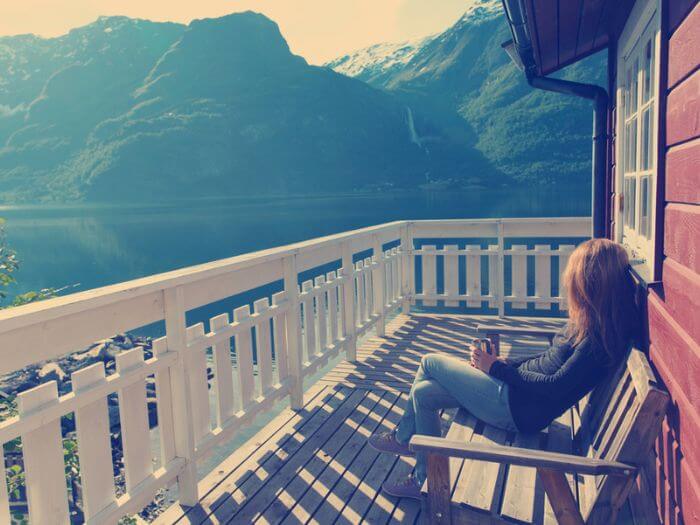
So there you have it – 96 common Norwegian phrases covering everything from greeting people to eating out to moonshine emergencies!
Now all that's left to do is to start using these common Norwegian phrases in conversation.
The best way to remember and start using these common Norwegian phrases is to follow the rules of StoryLearning and read short stories in Norwegian.
As you read, you'll see these phrases over and over and you'll soon be using them naturally yourself, without having to study and memorise them.
In the meantime: Ha det bra!

Olly Richards
Creator of the StoryLearning® Method
Olly Richards is a renowned polyglot and language learning expert with over 15 years of experience teaching millions through his innovative StoryLearning® method. He is the creator of StoryLearning, one of the world's largest language learning blogs with 500,000+ monthly readers.
Olly has authored 30+ language learning books and courses, including the bestselling "Short Stories" series published by Teach Yourself.
When not developing new teaching methods, Richards practices what he preaches—he speaks 8 languages fluently and continues learning new ones through his own methodology.
